A Ride to Nana’s House
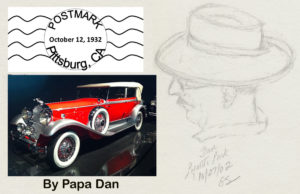
Dedicated to my timeless sister.
View a PDF of this post:
76-ConVivio_1931_Packard
Danville, California — A rainy Sunday afternoon was made to order for a trip to a museum; and just a few miles up the road in Danville, we’ve got the famous Behring Auto Museum. Since we had never seen it, Gretta and I decided to spend the day strolling through one of the finest collections of classic sports cars on the West Coast.
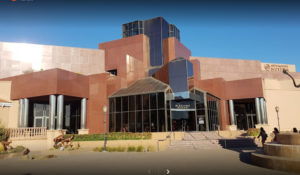
The modern building has polished stone floors, elegant lighting, and two stories of magnificent cars — some of them one-of-a-kind, many specially built for royals or movie stars. After just a few minutes surrounded by the likes of a 1933 Alpha Romeo, the only existing 1911 Silver Ghost Rolls-Royce, and Howard Hughes’ black 1929 Duesenberg, I felt transported to another time.
Trying to visualize a street where cars like these were actually driven took some serious imagining. But when I literally (ooops!) bumped into the magnificent 1931 red-orange convertible Packard 840 Deluxe Eight, my imagination was fully engaged. I pictured myself face to face with Jay Gatsby in his circular West Egg driveway, one foot on the running board, adjusting the mirror strapped to the spare tire, polishing it with the handkerchief from the breast pocket of his white linen suit. The uniformed security guard didn’t much like the fact that I had accidentally touched the classic, “Please be careful, sir. We much prefer that you not touch … ”
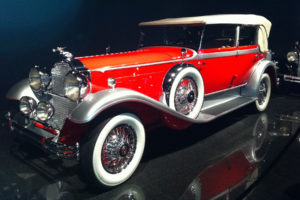
Yes, I’m sorry, it sorta snuck up on me.”
I grinned but he was not amused. So I offered
what I thought wound be an additional apology:
“This one is just stunning, don’t you think?”
“Yes, sir. The Packard does bring a person
back to a more … interesting … time.” His
expression suggested that he had some
experience with that time — and he seemed
to prefer it to now.
“I bet you know these cars better than anyone, Mister … uh …?”
“Yes, sir. Carraway, sir.”
“Do you ever get to drive these cars, Mister Carraway? I mean, after hours maybe, when no one’s around?”
“I WOULDN’T THINK OF IT, SIR!!” He raised his voice a bit and looked me in the eye for the first time, as if I had accused him of something serious. I grinned back at him as if to share a guilty secret. He looked away thoughtfully, back to the Packard. “Owners take some of them out from time to time, keeps them alive, so to speak. But this one … ”
“This one is different?”
“Yes, sir. Different. Special. Has a life of its own and a tragic story. Timeless, you could say. Really should be driven regularly; it’s pretty smooth for an eighty-five-year-old.” The first hint of a smile appeared and was quickly withdrawn.
“Now you’ve got me intrigued, Mister … uh … Carraway, you said. Sounds like you’ve gotten to know this one.” No reaction. “I read in your brochure that they made only a few of these. The sticker price was pretty steep — $3,200 was some real money in 1931, eh? I wonder how many people could consider buying one of these in the depth of the Depression?”
“Only one that I knew at the time.”
“At the time … ?”
The straight-faced guard looks at his watch, “Sir, you know it’s getting to be time to close. You’ll forgive me if I begin.”
“Of course, I’ve taken too much of your time already.”
“Not at all,” he said, turning to leave.
Alright, I couldn’t resist — “Mister Carraway, one more thing, if I may. If a respectful gentleman were to … uh … linger here at closing time one day, if he were willing to wait a while, quietly … I wonder if it would be possible — not to drive it, of course, but when you … perhaps … uh …”
“Forgive me, sir, I really must close.”
“Of course, perhaps we’ll talk another time.”
He nodded but said only, “Good afternoon, sir.” It was clear that I had been dismissed.
Over the next week I just couldn’t get that ’31 Packard out of my mind. I imagined Mister Carraway locking the museum doors at closing time, setting the alarms on the public entrances, and slipping back to the shop area to retrieve the keys to the Packard. In my melodramatic imagination, he would turn off the closed-circuit surveillance cameras, push the red-orange beauty through the back door into the shop, start it up, and drive it out into the back lot. I wondered if he had the nerve to take it out into the public parking lot or even — NO WAY — out into the nearby residential neighborhood. Of course, the fact that this magnificent vehicle would be completely out of place in this neighborhood and … well … in this time, made it a ridiculous idea. It isn’t something he could pull off unnoticed.
As the days passed, I became increasingly convinced that Mister Carraway did exactly that — and I indulged my outrageous fantasy that I could somehow join him on one of his rides. But how? Maybe if I did some research and showed up spouting a wealth of knowledge about the ‘31 Packard and not a little admiration, maybe he would be impressed by my love of the machine and its history and give me a ride. It wasn’t a great idea, but it was the best I had; so, I turned to the Internet.
The results of my search were quite interesting. It seems that Packard made a strategic decision to try to beat the effects of the market crash of ’29 by building a vehicle even more luxurious and more expensive than ever before. They figured that those who still had that kind of money would want the most opulent model they could find and would abandon the mass-produced “luxury” cars like Cadillac, which they judged, would soon be going out of business. It sounded like a half-baked strategy to me; and it turns out that they badly misjudged the very small number who would survive the crash with that kind of money and ended up building and selling precious few of them.
So, ten days later, after doing my homework, I showed up on a weekday afternoon when I hoped there would be fewer visitors. I found Mr. Carraway leaning against one of the “Please do not touch” signs, looking bored. At the risk of being a pest, I greeted him: “Ah, Mister Carraway, nice to see you again. Last week I fell I love with your ’31 Packard over there and I’ve done some reading. It has a bit of a history.”
“Yes, sir, I remember your interest. It does have quite a history.” He followed me as I walked over to the red-and-orange beauty.
“I learned that the few who owned one of these included some big names — some Hollywood folks, some politicians, ‘captains of industry.’ I’d love to know who owned this one.” I touched the hood gently with what I thought was proper respect.
“Sir, PLEASE.” With a deep frown, Mr. Carraway took out a handkerchief and wiped my fingerprints off the hood and made a visible effort to quell his annoyance that I had been so presumptuous to have touched the Packard on purpose.
“I’m terribly sorry … I’ve done it again. Please forgive my carelessness. I know it’s no excuse but I do feel such a connection to this vehicle. Makes me feel that somehow, we can connect to the world it comes from — something I’d love to do.” With a thoughtful nod, he seemed to approve of my feeling of connection. So, I plunged into my strategy: “I read some stories on the Internet — and I remembered that you mentioned a “tragic story.” I read about Jean Harlow and how she had a Packard like this one. I was hoping to learn more. I keep thinking about all the stories these cars could tell about the people who came before us. What do YOU think?”
He hesitated, then looked me in the eye; it was 4:30 and the place was almost empty. Before he could tell me it was time to leave, I continued, “I was hoping we could talk more about the tragic story you mentioned last week.” To my surprise, he suggested that I wait here while he closed up shop. “I’ll be a few minutes,” he said.
When he returned after securing the public entrances, he told me that none other than movie executive Paul Bern had bought this Packard for actress Jean Harlow on her 21st birthday in 1932 to celebrate the movie contract with MGM he had negotiated. They were married that year but two months later he committed suicide. And when she died suddenly only five years later, the car became he property of the MGM studio.”
“Oh, my. I read that story — I was captivated. So, THIS is the one! What a privilege to see it!”
“The very one, sir. The heirs donated it to the museum when it opened in 1988.” He hesitated, seeming to make a decision about what to say next. Finally, “It has some ‘remarkable features.’”
“So, it still runs. Wow! Remarkable features, you say? Let’s see, I read that its larger valves, a special fuel pump, and a preheated fuel mixture increased its power and it was one of the first cars to exceed a top speed of 100 miles per hour. Pretty remarkable for the 1930s.”
“Well, OK, you have done your homework. Those are certainly some of its mechanical features,” — with a chuckle — “but there is much more to this Packard than meets the eye.”
“Mister Carraway, I fear I’m being rude, but … do you suppose … I would like to get to know this wonderful heirloom, if I may … and you seem to know it well.”
Before I could find words to ask my outrageous question … he raised his hand and interrupted, “Sir …” and he stopped, looked around with a pained expression, apparently considering carefully what to say next. With nobody within earshot, he bit his lip and looked me up and down carefully and then focused on my eyes. “Sir, … I will need your absolute assurance that what I’m about to show you will be our secret.” After I agreed, he said quietly, “Please wait here … and, Sir, PLEASE don’t touch anything” and he was off to fetch the keys.
The Packard started up with a metallic roar and he steered it off the exhibit floor, out the door to the maintenance bay and, to my surprise, drove us straight to the back of the parking lot and onto Blackhawk Plaza Circle. After the familiar bend to the left, instead of the freeway on-ramp I expected to see, he turned right into a two-way country road I didn’t recognize. He noticed my surprise, and said, “Where would you like to go?”
I answered with my best grin, “You’re in charge. Where are we allowed to go?”
“Well, our travels are governed by two conditions. One: we can drive anywhere there is a suitable paved road and you’ll notice ready that we are on a road that is unfamiliar to you. That brings us to our second condition, which is not so much about “where” but “when.”
“Excuse me?”
“You will remember I told you this Packard has special features — this will be hard to believe, but I hope you will be quickly convinced. I can’t explain why or how, but once this vehicle leaves the confines of the museum, it “lives” in the 1930s. Back then, this town was primarily a farming community of about 2,000 people. This rural road was replaced in the 1950s and 60s by a system of freeways; but in 1932, it wandered north and east through farmlands that you know today as Walnut Creek, Concord, Pittsburg, and Antioch. As you read on the website, this car was owned by the actress Jean Harlow from her 21st birthday in March of 1932 until her death in June of 1937. Outside of the museum, this car travels any time between those dates.”
I stared out the window at the green hills for a long minute, then turned back to him, opened my mouth to speak, then closed it and turned back to the window. Finally, I took a deep breath and said, “Let me get this straight, you are telling me that you are a time traveler, is that right?”
“Yes, and by the end of the day that, today, here in Jean Harlow’s Packard, you will be a time traveler as well. Now, how this all came about is a longer story for another time. But for now, again, where and when do you want to go? Does anything in the 1930s interest you?”
Once again, I stared out the window, trying to process this startling information. (I thought, ‘what have I got to lose? What the heck?) “OK, so let’s say I believe you. We seem to be heading toward where my sister and I grew up a long time ago,” I said. “She was born in Pittsburg in 1932, a few miles from here. Since I wasn’t there at the time — I was born much later — can we go there … uh … then and have a look?”
“Sure Have you got an address and a date?”
Where and When
My sister and I grew up in two very different households, although with the same parents. Born in the middle of the Depression, hers was a depression-era blue-collar family. Her father, Albert (known as “Al” or “AJ”) hadn’t finished the 8th grade and worked in the local steel mill. Money was tight and Al and his wife Mae lived in a back bedroom in Mae’s parents’ house (‘Nana’s house’) on 12th Street in Pittsburg and they didn’t own a car. By the time I came along in 1950, Dad was making serious money as an insurance agent and they lived on Manville Avenue on the other side of town. My sister, Anita Mae, was born in Nana’s bed in the house on 12th Street. It was a big house and it was full of family. Her five-year-old Uncle Tony, the youngest of nine children, called her ‘Honey Bunny’; and the name stuck — shortened to “Bunny” — all her life.
“Mister Carraway,” I said, “How about 12th Street in Pittsburg, October 12th, 1932, at 11:20 pm. It’s a corner house with wide plank steps up to a front porch.”
“That’s pretty specific. What’s happening?”
“I was told that my sister was born in the front bedroom of that house on that day, at that time.”
We pulled up to the house on 12th Street at 11:20 pm and the only light shone through the window on the front porch to the right of the front door. And there’s the porch swing I remembered. I could hear voices from through the door. “Wow! That’s the front bedroom. I remember it from when I was a kid.” Looking at my watch, “It’s time. My sister is being born right now in that room. … So, now what?
“Well, there’s not much to see from here. Probably shouldn’t get out of the car. Remember, you’d just be an intruder this time of night. It would be very dangerous to interfere.”
“Right. Nobody in there would know me. I don’t join the family for another 17 years. This is pretty weird, Mr. Carraway. Pretty weird.” To my surprise, he agreed.
He drove around the corner and pulled over to the curb, the big V8 engine idling. I’m thinking, ‘what can I do with this opportunity?’ This house is where my sister and my parents lived for another three years or so before they could afford to rent rooms from the Grabstein family on East 7th Street. They lived there until about 1937, the year Bunny skipped from kindergarten to the second grade — she had already learned to read — when they moved and rented an upstairs flat with an outside entrance from the Permesso family on 4th near York Street and Dad bought his first car. It wasn’t until about 1940 or so that they moved to the house on Manville — where they lived when I was born. So, I took a shot in the dark …
“I know I’ve taken a lot of your time already; but can we try one more thing?”
“Sure,” he smiled,”I’ve got time. We’ll be able to pick the time we want to return to the museum. Name it.”
Back around the corner, same house, a year or so later? Maybe a Saturday afternoon? Maybe we’ll see someone.”

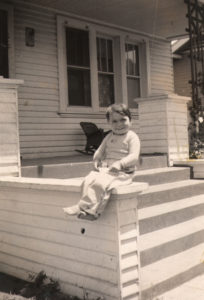
So, we drove around the block, to daylight on the same corner, and … THERE THEY WERE! A little girl — my sister about a year or so later — appearing to be taking her first wobbly steps and her mother — my mother long before I knew her — taking pictures with a big clunky camera.

Mr. Carraway’s big grin betrayed that he was
as thrilled with this time-travel stuff as I was. “Let’s try one more. Pick another one.”
I remembered an old family photo with a Mother’s Day story — “OK. another shot in the dark. Let’s try May 12, 1935, a Sunday afternoon.”
Around the block we went again and there was my sister in the front yard, a serious three-year-old all dressed up for Mother’ Day.
Of course, I had an almost overpowering urge to get out of the car, walk up to my mother and sister and introduce myself — wouldn’t that be something! But I recalled Mister Carraway’s caution when we first arrived: “… it would be very dangerous to interfere.” As I looked at this scene from long ago, I couldn’t help but wonder what would happen if I did ‘interfere.’ How much trouble would I cause? I imagined the obvious:, that I would risk changing the past. If that happened, I supposed it would change the future — that is, the “present” that I intended to return to back at the museum? The possibilities were immediately frightening and I forcefully put it out of my mind.
Mister Carraway interrupted my pondering — “OK, I think we got what we came for. This fancy car’s going to attract some attention. Doesn’t quite fit in with the neighborhood, if you know what I mean. We should head back.”
“Right. Mister Carraway, this has been incredible, so much more than I imagined possible.”
The ride back to Danville on that country road was pretty quiet. I had trouble finding words for the experience of visiting the 1930s. Looking at the house I loved as a kid, Nana’s house, long before I knew it, was simultaneously familiar and completely foreign. I had wanted to stop and talk to my young mother and “little” sister, walk up the steps where I used to pretend to speak to a cheering crowd (like I saw in the movies). I wanted to sit on the porch swing just as I had done as a kid in the 1950s; but, as Mister Carraway said, I would have been a stranger, an intruder.
On the ride back to ‘the present,’ I remembered with great irony, that my nephews and I used to sit in that porch swing in the late 1950s and exercise our lively imaginations. Visiting Nana’s house when I was nine and my two oldest nephews were seven and five, we pretended that the swing was a magic bus. We used to dial up where we wanted to go. We would sing a little jingle from a TV toothpaste commercial and it would take us wherever we wanted to go — just like this magnificent 1931 Packard had done “today.”
If only we had known.
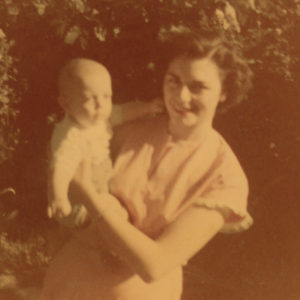

Baby Danny (me) and my sister Bunny Bunny, her husband Joe, and one of their sons,
in that front yard, 1950. Stephen, on one of several “Magic Buses” from that era.

Bunny, more recently
![]()
Notice: Undefined variable: time_since in /var/www/wp-content/themes/mts-journey/single.php on line 12
Saturday, May 5th, 2018,
by Daniel and is filed under "Family Stories, Fiction, Time Travel ".
Both comments and pings are currently closed.
||
I love it! In particular, I love the way you drew us into a story that led to an entirely different story, yet the first was integral to the second.
It’s interesting that it was all as you remembered it. Memory sometimes plays tricks on us, so perhaps you would have seen something you didn’t remember. On the other hand, you spent a lot (?) of time there as a child, so maybe the key details stuck with you.
I remember that the house was on a corner, so it was nice to have that confirmed. Other than that, all I remember, from visits that my family made in the early 60s, was that the front room was a parlor and behind it was a dining room (we once were served something delicious there — ice cream?), and that beyond that there was a door that we were forbidden to even go near. Who would have been living in the back bedroom in the 1960s, years after Nanu had died?
Tom
Very enjoyable. A time machine, whatever its makeup, is always a favorite of mine.
I remember Bunny! She is awesome. And that picture of your Mom…she looks just like Will did at that age.
Thank you for taking up on your Magic Packard Car Ride into the past. Everybody needs a Mr. Carraway in their lives. You are very lucky indeed to have come from such an amazing family and to have such a magical friend.